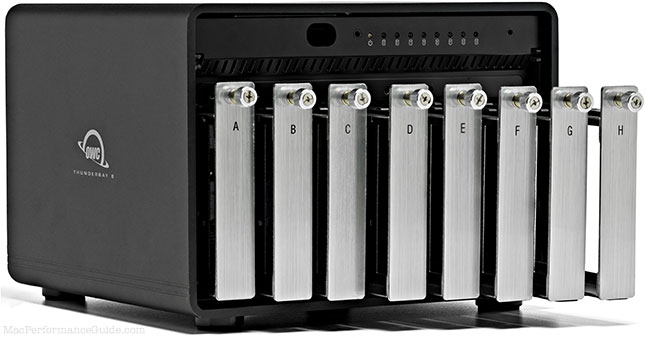
|

|

|

|

|

|

$220 SAVE $130 = 37.0% Western Digital 16.0TB Western Digital Ultrastar DC HC550 3.5-in… in Storage: Hard Drives
|

|

|

|

|
Photographic Film Really Was Not Much of a Performer
Related: acutance, diffraction, digital sensor, dynamic range, Eastern Sierra, Fujifilm GFX100 II, Fujifilm medium format, gear, How-To, James G, loupe, Luc O, Mamiya 7 II, medium format, Murray O, noise, peak bagging, post processing, raw file processing, Roderick W, shutter, State of Arizona, State of Utah, true-color sensor or image, Yosemite
I went back to look at high-res drum scans (Tango and Imacon) of my 4 X 5 and 617 large format 'chromes' (color reversal film, mostly ISO 50 Fujichrome Velvia). I was struck by just how unsharp they looked, and yet they were made with top-grade gear. So my next thought was “user error”. But every image shows the same limitations in all all formats (4X5, 6X17, 6X7, 35mm). I must have had world-class talent to be so consistent!
Film was never all that sharp. Real sharpness (in spite of silly calculations) was not anything close to what a Nikon D810 can do with good glass, and film dynamic range was terrible compared to the best digital sensors of 2015 onwards. Any 10X or 20X loupe on a critically sharp chrome made that clear (unclear) enough, let alone the grain even with ASA 50 film. The limitations of f/32 and indeed even f/22 are shockingly apparent with a 20X loupe, versus f/16.
With just two horizontal images (stitched), I posit that my Nikon D800E could easily outperform the frame seen below from my Linhof Technorama 6 X 17 S III (617 S III), even accounting for losses from overlap. Of course, a Seitz digital 6X17 would be another matter. A properly done iPhone pano is better, I think.
Click each image for a larger version.
Film below was scanned at 15972 X 5366 (image area from 17732 X 6066). Probably shot at f/22, Fujichrome Velvia 50. Sharpness is consistent with many other 4X5 and 6X17 images.
Size 11648 is the width of the Fujifilm GFX100 II sensor. Whatever appealing non-digital qualities it has (yes it does), the sharpness is abysmal compared to digital.
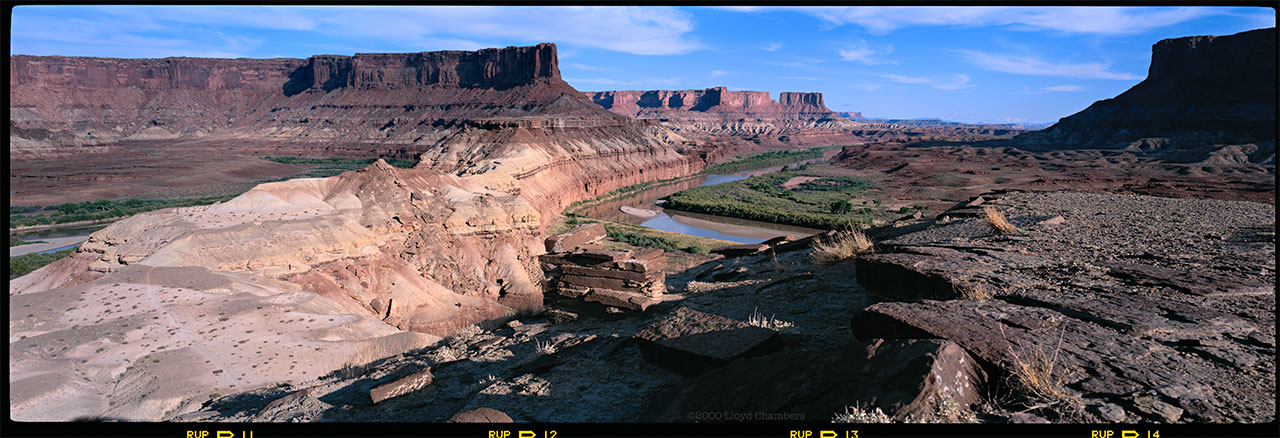
Linhof 6 X 17 S III, 90mm lens, Fujichrome Velvia 50
Shown below is the small island in the river at center. At the time I thought this film to be thrillingly sharp, and indeed it looks lovely with a 3X loupe, but a 10X loupe shows its clear limits as we see here.
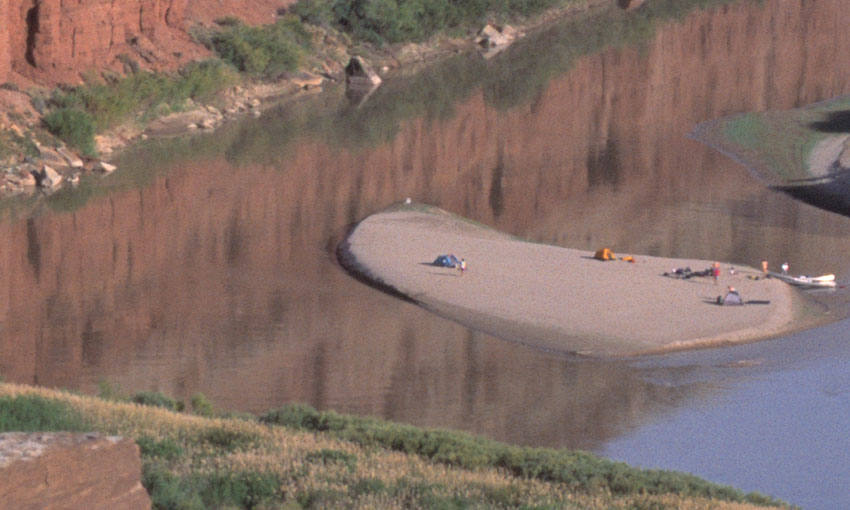
Diffraction for film and digital
In Making Sharp Images, the choice of aperture can either improve an image, or offer huge degradation, particularly for high resolution cameras like the Nikon D800E. The issue is a law of optical physics: diffraction.
The diffraction 'hit' is no different from film days. That film suffers the same effects can be observed using a 10X loupe on ISO 50 fine-grained color reversal film: I made such examinations over the years with my 4 X 5 and 6 X 17 cameras. On film, f/16 was a sweet spot for large-format quality, f/8 for 35mm (film having relatively limited resolution once grain is accounted for and a natural acutance effect). Use of f/22 was perfectly acceptable with large format, but with a loss of micro contrast becoming visible, and by f/32 fine detail was obviously degraded.
Another example
This image shows similar resolving power to the one above, which is to say little more horizontal resolution than that achievable in one frame with a Nikon D800E and top-grade lens. A D800E with two stitched frames could run rings around this kind of resolution, producing something in the 12,000 pixel range after stitching two frames. For that matter, an iPhone pano can be really good, unlike its stills.
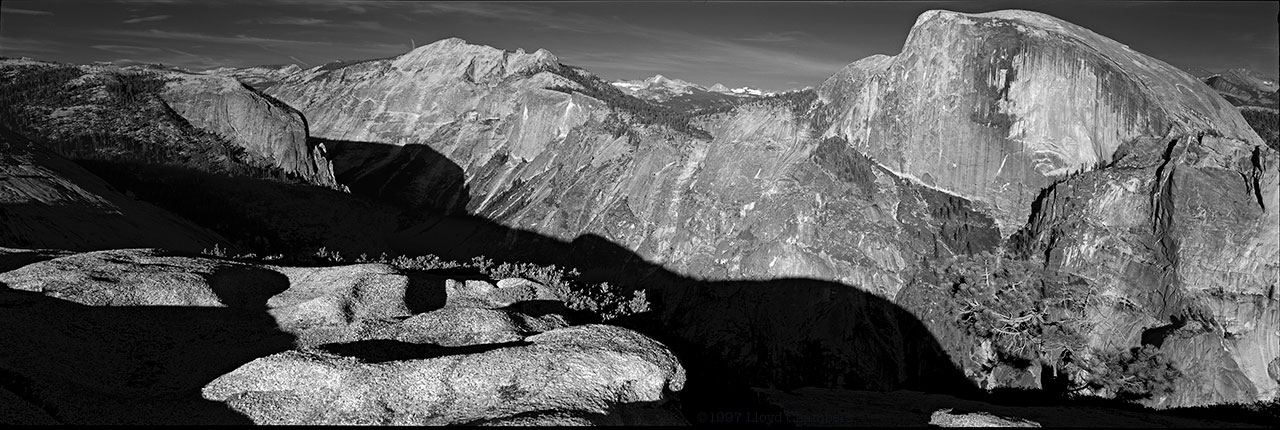
Linhof 6 X 17 S III, 90mm lens, Fujichrome Velvia 50
Actual pixels at the base of Half Dome.
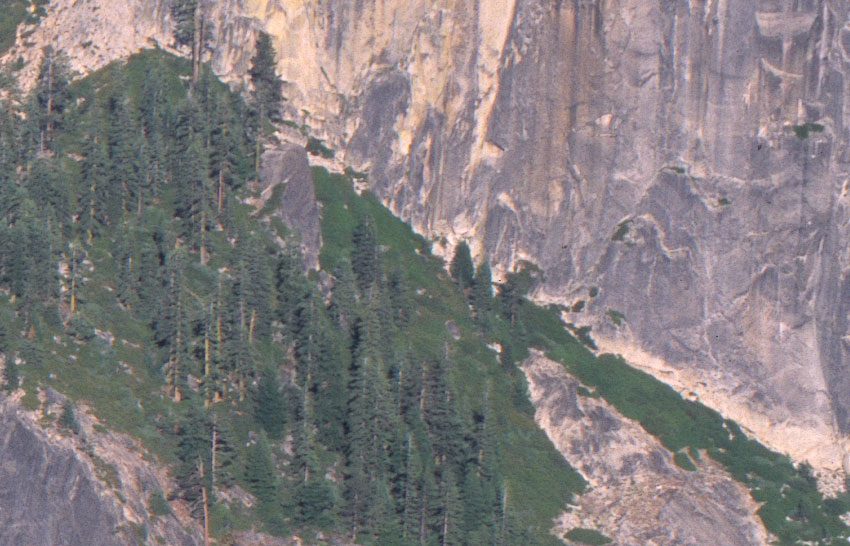
35mm sucked just as much
One cannot argue with the gorgeous color rendition of a 'chrome'. Nothing like any chrome on a light table for gratification. Just don’t get out the 10X loupe folks.
The image below was an 5924 X 8515 drum scan (50 megapixels). But is it sharp? I’d rate it at a third or less of what a Nikon D800E can do, and that’s being charitable.
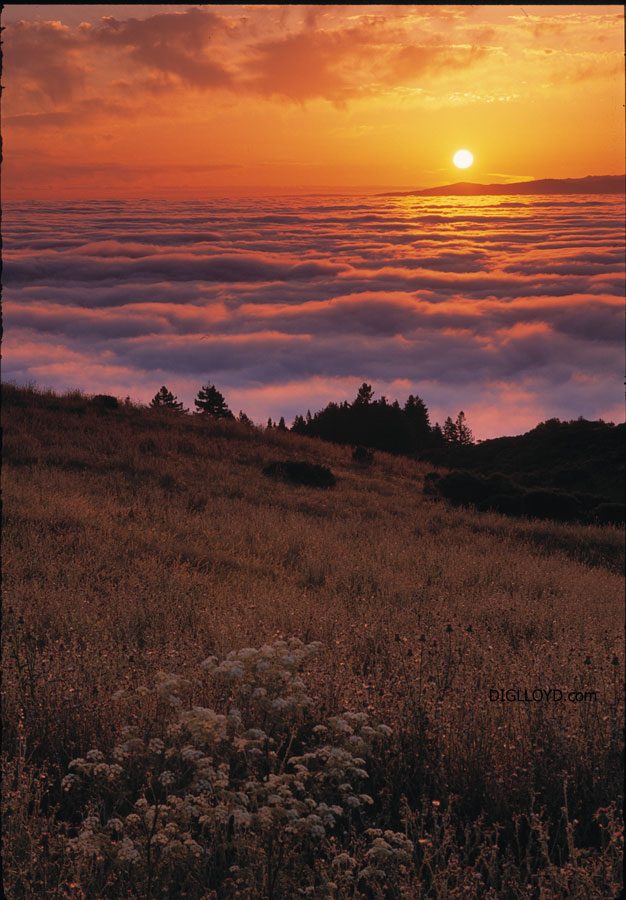
Nikon film camera of some sort, Fujichrome Velvia 50, 5924 X 8515 drum scan
And look at the NOISE in this digital camera which the manufacturer shipped with a dirty sensor—oops I forgot it is fine-grained ISO 50 film and that film gets dirty awfully easily.

35mm Kodachrome was in theory sharper, but oh the contrast
My Kodachrome scans made some years ago are sub-optimal, but they show little evidence that better scans could offer significantly more actual sharpness. The main issue with Kodachrome was contrast. Under the right conditions one could obtain “wow” results. The rest of the time “ouch”.
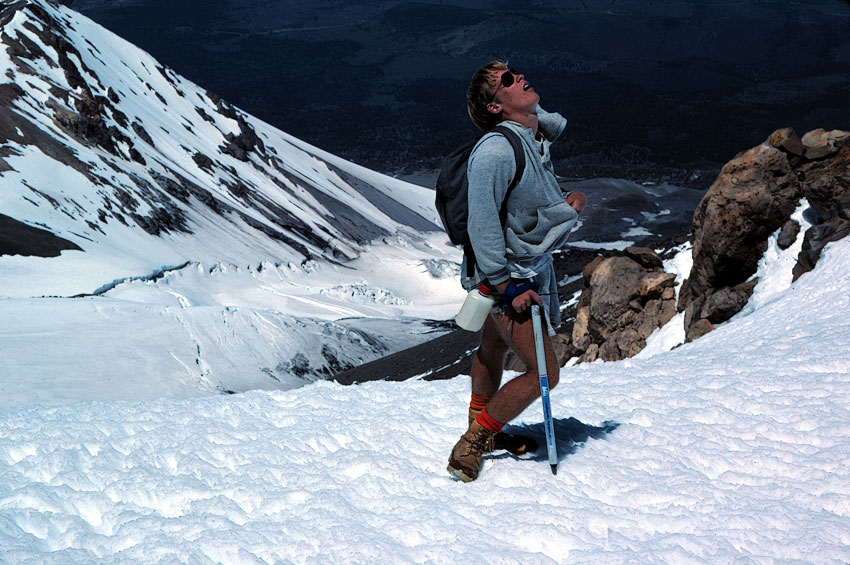
Nikon FE-2, Kodachrome 25, 3556 X 2368 scan
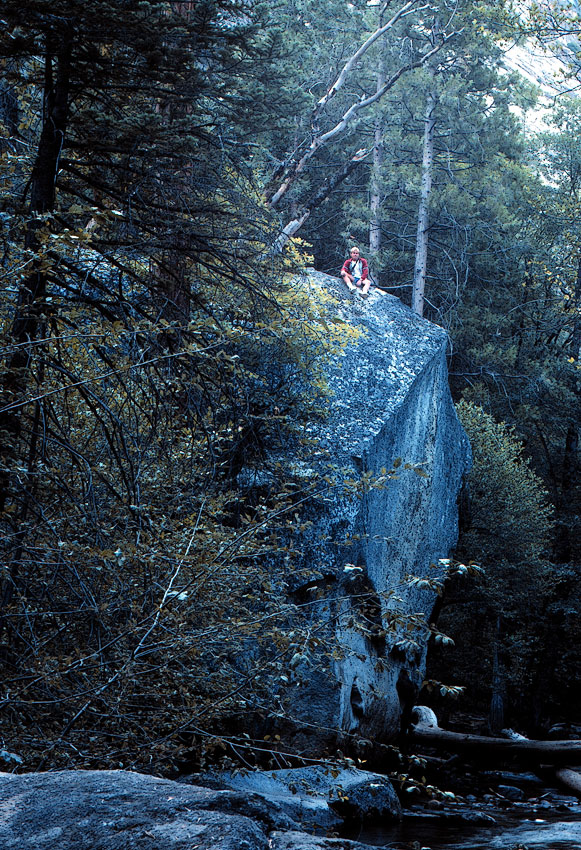
Minolta XD-7, Kodachrome 25, 1954 X 2859 scan
Want highlights and shadows? Forget about it with Kodachrome.

Minolta XD-7, Kodachrome 25, 3603 X 2313 scan
6 X 7 had clear limits
The Mamiya 7 II was a terrific film camera with first rate lenses. But its detail per square inch of film was no better than 35mm, and just sufficient to make a sharp 24 X 16 print. Larger than that, and the limits were clearly visible. I’d put my D800E up against 6X7 any day.
I recall a New York Pro proudly showing me a 4-foot print from Mamiya 6 X 7 and exclaiming how sharp it was— I did not correct him; to me it looked quite blurry! Old conceptions die hard, or just don’t die at all. It was a fine print that was selling well, that’s art and all well and good (nor should we get hung up on sharpness). But the fact is that it was not anything I would have called sharp. Ditto for the large Ansel Adams prints from 8X10 that I saw in the Adams family house.
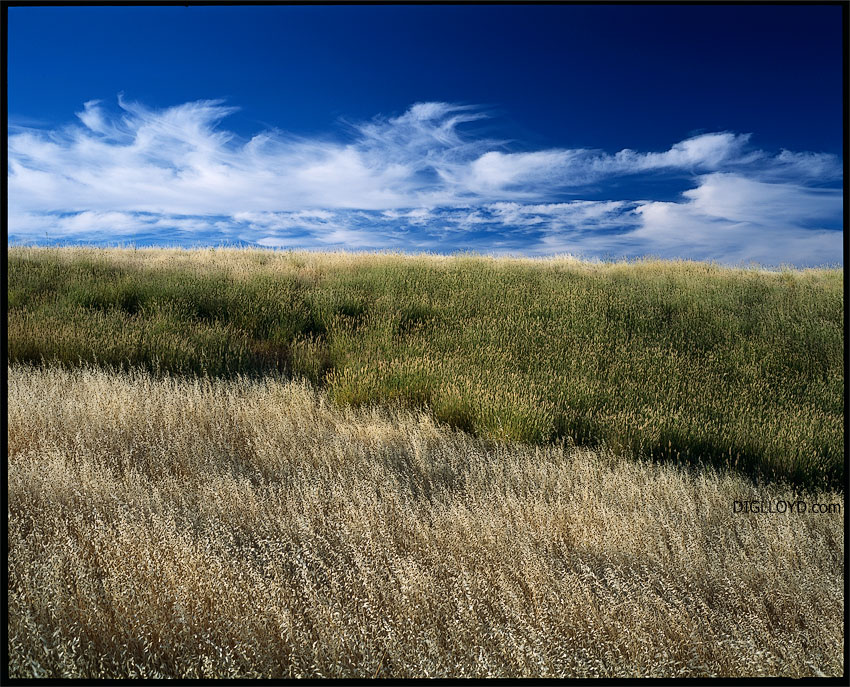
Mamiya 7 II, Fujichrome Velvia 50, 11470 X 9270 drum scan
Beautiful color, but the detail capture here is really only good enough for a 16 X 24 print. If a Mamiya 7 II with 150mm lens on 6X7 is not about as good as it gets for film short of large format, it surely shows that film has strict limits on detail. This shot was on a tripod, my guess is that it was taken at f/11. Yet I’m sure that a Nikon D800E could have easily out-resolved the Mamiya 7 II here, as one can tell in looking at the actual detail on film (which was aggressively sharpened for this image).
Downsampling the 9294 pixel scan, one can easily conclude that it does not have the 7360 pixels worth of resolution possible with a D800E. At best it is somewhere in the 5000-6000 megapixels range (16-24 megapixels equivalent for a 3:2 image).

Mamiya 7 II, Fujichrome Velvia 50, 7242 X 9294 Tango drum scan
4 X 5 sucked less
Well, 4X5 sucked somewhat less by sheer film area. But of course less-than-flat film does not help matters, so you stop down more and diffraction is your enemy there. So you get beautiful tonality but whether you get a lot of detail or not all depends.
Surely with better lenses (Rodenstock APO seemed pretty good to me then) and more skill I could have done better, but there isn’t much skill required to focus on a distant scene as shown here, yet the sharpness does not impress. So I remain skeptical that 4X5 really can do all that much when looked at critically. Ditto for my other 4X5 images, some of which I printed to 4 X 5 feet and at the time I thought were sharp. Heck, the Sigma DP Merrill at 40 X 30 inches looks competitive.
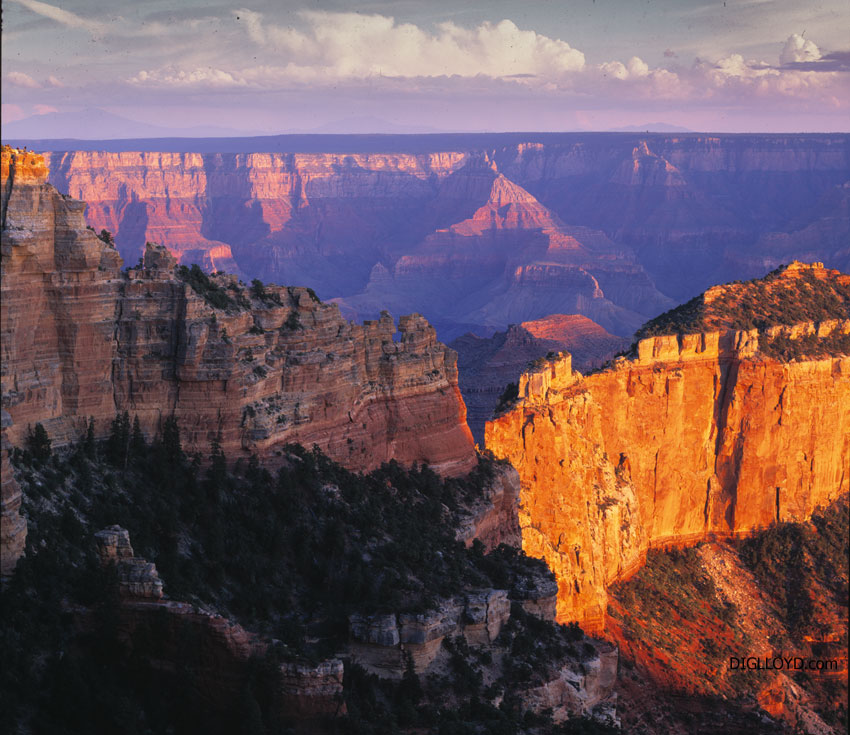
Linhof Technikardan 4 X 5, Fujichrome Velvia 50, 7565 X 6560 Imacon scan

Linhof Technikardan 4 X 5, Fujichrome Velvia 50, 11736 X 9220 Tango drum scan
Bottom line
All of these formats show one remarkable thing: at their best they all delivered similar sharpness per square inch of film, the larger formats perhaps a little less so because of needing a little more stopping down and in theory slightly better lenses for smaller formats. But tossing aside these relatively small nuances, the sharpness I see in ALL my film formats was pretty much the same: hugely inferior in sharpness on an area basis to my Nikon D800E.
Eight-bay Thunderbolt 3 high-performance storage for photo and video.
Hard drives or SSDs.
Non-RAID or RAID-0/1/4/5/10.
Capacities up to 144 Terabytes!
James G writes:
Another nail hit squarely on the head with that one. Ironic that I was reading this as part of a time-killing exercise while waiting for my Imacon 848 to complete a 35mm Provia scan.
It's shocking and disheartening to see this, but it is oh so true. I was an obsessive-compulsive lunatic in my late film days, going to crazy extremes to achieve sharp 35mm slides. I thought I did really well - they all looked tack sharp under a 10x Schneider loupe. But scan them at 8000 dpi and all hell breaks loose.
I've scanned 35mm slides on everything under the sun from an ancient Nikon Coolscan LS-10 to a Howtek D4500 to several varieties of Imacon and the results are always the same. You can get razor-sharp grain, but the images themselves are often very soft, especially when you're used to digital originals.
After a great deal of experimentation, I've determined that there is absolutely no need whatsoever for 8000 dpi on 35mm. All that does is give you a huge file and no benefit. In fact, after lots of serious analysis, I've concluded that even 4000 dpi is likely overkill in most cases - a measly ~22 MP (realizing that scanner pixels aren't quite the same as DSLR pixels).
What we really need is a time machine so that we can go back in time and get those irreplaceable images captured properly in the first place. But if Nikon's D4X has 54 MP, I guess maybe that will be almost as nice.
...
In some scans I did of very sharp Kodachrome 25, I found that you really don't start to lose a lot of significant detail until you get in the 3000dpi range, which really surprised me.
One thing I did note is that it MAY pay to scan at 8000dpi to avoid "grain aliasing". My current procedure is to make my scans at 8000dpi, but then down-sample them to 4000dpi before saving them in my archives. This seems to produce a file with all the detail of the 8000, but much smaller and without the grain.
DIGLLOYD: it is shocking to have in one’s head a sense of what the D800E can do, and then go look at one’s best chromes. They look beautiful as chromes, they look beautiful at computer-screen wallpaper size reductions, but boy do they suck technically on the resolution and grain front.
And the grain... well the forum denizens would beat the living crap out of any digital camera with that kind of noise.
As for equivalent resolution, my estimation after resampling my film scans of all sizes is that a good 35mm film scan equates (being charitable) to about 1/3 of a good quality Nikon D800E image: about 12 megapixels at best. Which matches closely with the estimate by James N above. Except that I'd rate it closer to 8 megapixels in terms of perceived quality.
So I downsampled a number of my 13000-21000 pixel-wide 6 X 17 scans to 7360 pixels wide—same as the Nikon D800E in width (but less in height). I was astonished to find that the perceived sharpness was somewhat less to roughly equal to the D800E, except that sharpness to the edges declines. So even with huge film, I would have to rate the D800E higher even with a single frame. Stitch two D800E frames and it’s game over.
Roderick W writes:
Very interesting comments on film. I pulled out my “Best” print. Nikon FE2 + Nikkor 55 mm f2.8 Micro, Probably at f8. Heavy tripod. Kodak Tech Pan, rated at 4 ASA, developed in Technidol. Printed on a Durst enlarger with a Rodenstock lens (which one I cannot remember, but it was long focal length so the film carrier was out of reach!) The paper was Ilford Galleria processed through to a Selenium print. I had taken a roll of film and spent days in the darkroom. The subject was a conglomerate rock on the seashore with an incredible range of micro structure and delicate contrast. I compared it with an Epson A3B print from a D800E + Zeiss 21 mm of some wild orchids. The prints are the same size. The Black and White from film is at its maximum enlargement for close examination, 20 x 16 inch. The colour print invites enlarging further, but my printer doesn’t go there! I intend a pilgrimage back to Scotland to find the same or similar rocks 25 years later to see what I can do now.
My best 35 mm Kodachrome 25 ASA transparencies still look good on the screen, but I rated them not much better than files from a D2X when I got one. The D3X was a step up in flexibility and quality, now the 800E renders well loved transparencies disappointing when projected. Such is memory against reality. There was an Ansel Adams exhibition of his own prints in London earlier this year. I was surprised at how low the resolution actually was. The artistry in some of the shots however did not disappoint.
DIGLLOYD: Indeed, artistry and sharpness are very different things.
Martin F writes:
It was fascinating to read this article as someone who is considering a small field camera as a cheap alternative to PCE lenses on my D800. While I was very aware from simply looking at my old scans that film had tangible limitations, I put it down to gear and user error- lab-developed films, scans from flatbeds or a Nikon LS8000, etc.
However, I would argue that your photos in the above article (each of which is prefaced with a disclaimer that a given film format "sucked") are significantly more aesthetically pleasing than the majority of photos accompanying your reviews. Not that i would attribute this difference to the camera, lens or film stock used, or even the photographer. I would be very proud to call any of the film shots posted my own, and would even happily endure the inevitable comments along the lines of "wow, what camera did you take THAT with?"
Of course, on the subject of gear (a subject that concerns us all far too much), I still hope dearly that larger manufacturers like Canon and Nikon decide to venture into the medium format market, as the larger sensor sizes clearly have something to offer. The attention of a major manufacturer would not only improve public awareness of the quality possible from medium format digital, but improve the standard of the technology and (hopefully) bring the prices somewhere below the dreams of avarice.
DIGLLOYD: In my reviews I have to cover a lot of ground, fast. I have equally good examples in many places in Guide to Leica and Guide to Zeiss, but it is true that a lot of stuff has to be shot yesterday in order to provide the steady coverage I do. The few times a year I can travel to the mountains, that is where I enjoy making more enjoyable (to me at least) images, but even there demands of comparisons, etc preclude the good light since it changes too fast. This spring with shoulder surgery and some illness even now I really missed not having my trip to Death Valley.
In short, I cannot make the kind of outdoor landscape shots under the 'newsroom conditions I must operate under— not unless I cut back to about 1/10 the gear I do. And then I would have to find another job, because this site has to pay the bills. I love what I do, but like any job, I operate under the constraints of reality.
As for medium format from Nikon and Canon (and hoping I am wrong), I deem this to have a near-zero chance: there is no market for it; it would be a rounding error for those companies. The only chance I would see is for a “supercar” idea, whereby either company produces (for example) a 6 X 7 or similar fixed-lens camera for the same reasons auto companies produce some absurd 600 or 800 horsepower car.
Maurice D writes:
The chrome films (Ektachrome, Fujichrome etc etc) lost a lot of sharpness because of diffusion through the emulsion layers with built in dyes. Kodachrome which was basically a B&W film with the color being added during processing was much sharper. And of course the thin emulsions with less diffusion in the gelatin layer.
The emulsion thickness of film is the reason that Leica glass which seemed to focus perfectly on my M film cameras were off when used on my M8/M9 sensors which have no diffusion/tolerance and had to be recalibrated. Kind regards and thanks again for your very fine work
DIGLLOYD: Correct. With monochromatic light, film (and lens) are somewhat sharper than light of mixed wavelengths, but the light must diffuse through layers of emulsion. Kodachrome might have in theory been somewhat sharper, it certainly had less grain, but I never found this to be all that visible, which is why I switched to Fujichrome 50. Maybe I needed better lenses.
Years ago I shot and developed Technical Pan film. It was very sharp, but the color rendition was really monochromatic. :;
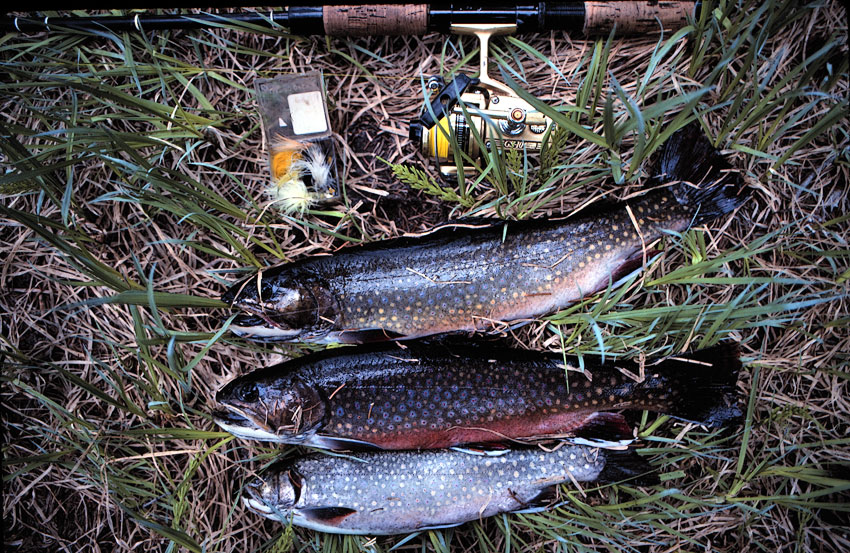
Minolta XD-7, Kodachrome 25, 3648 X 2374 scan
Murray O writes:
Thank you, you've just saved me the $2,000 I'd set aside for a nice M6 and ZM 2/35.
DIGLLOYD: Film has some appeal. Which for me stops when I have to develop and scan it and a high quality scanner has to be included in the cost unless one really is going to be using chemicals in a darkroom. A used Leica M9 and the Zeiss ZM 35mm f/2 Biogon makes a nice combo.
If I were to shoot film, I’d probably shoot a very low speed high resolving power black and white film for something really different.
Joseph C writes:
I’d have to agree with you on this, but would add that film even sucked compared to the 2nd generation 6MP digital cameras!
We started making wall sized prints about 8 years ago on a large job. We were also in the midst of transitioning from film to digital and were shocked that even our 6MP digital files seemed better than our 150MB scanned film files. Add in the hours needed to clone (not easy because of the non-random structure of film grain) out dust spots from film files (even those carefully cleaned!) and digital was a no-brainer for us.
DIGLLOYD: True enough. I have a large print of my daughters from a cropped 4MP Nikon D2H. To this day it looks good. Subject matter does exert some influence.
Nuno writes:
ALL digital cameras sharpen the raw data, by default and without any appeal.
Why don't you do the same to film scans? It's impossible to get sharp scans without it, due to the nature of scanning imagers, Tango or no Tango.Try Focus Magic: it works with both digital images and film scans and it produces some of the sharpest scanned images I've ever seen. Much, much sharper than the dross seen in most internet sites purporting to show film scan "sharpness".
Forget about USM-based sharpeners: hopeless for film scans!As well: get rid of the grain before sharpening with Neat Image and a dedicated sampled noise for each film type.
DIGLLOYD: I have no doubt that the film scans I have could be made to look better, just as I can make my digital images look sharper.
I sharpened the film images using Topaz InFocus with deconvolution sharpening. I tried light to highly aggressive sharpening. But film just isn’t very sharp to begin with and one need only pick up a 10X loupe to eliminate the scanner from the equation entirely. Or a print from an enlarger which bypasses the sharpening issue entirely, going direct from original to print. I made enough 16 X 20 prints years ago to satisfy myself that while digital can produce better results, the sharpness limits remain (but digital scans can be used to make things look better by enhancements of various kinds).
Film has built-in chemical sharpening (acutance). As with a digital camera, a scanner uses discrete sampling. Both require sharpening following the capture / scan. The only difference in favor of the scanner is that it uses a linear scan without a Bayer matrix so that it does a true RGB sampling of the material.
To my knowledge, digital cameras do not sharpen RAW files. Of course some processing has to be done to convert analog to digital, but it’s absurd to suggest that a conventional sharpening pass is done. For that matter, the demosaicing process has to occur! One need only disable sharpening when converting from RAW to see how blurry the image looks without any sharpening.
So of course I sharpen my raw conversions. And the film scans. It's not relevant to this discussion; mush does not turn into detail with any amount of film sharpening.
I aggressively sharpened this image below with a wide radius deconvolution approach. It helps lend the appearance of sharpness via better edge acutance, but it doesn’t deliver fine detail and it increases the film grain. I have no doubt that a more sophisticated approach would help even more, but I also have no doubt that the detail just is not there on the film to begin with, this example being fairly representative of a sharp 'chrome'.

Unknown camera, Fujichrome 50, 5184 X 7736 Tango drum scan
Luc O writes:
Beyond any “grain” of doubt, you confirm how much better the resolution of DSLR is better compared to film. Now FF DSLR like D800 get close to the resolution of a 6x17 ! For more usual cameras, arguments by readers suggest that 35mm film resolution ranges around 8MP. This seems right if we look past: once this 8MP resolution was achieved by DSLR, most photographers moved to digital. Moreover, lower noise, higher ISO, flexible white balance are additional compelling arguments in favour of digital medium. So why to write that “film has some appeal” ?
On my side, I continue to view some of the film merits being still at par more or less with digital medium: tonal range for B&W, skin rendition for color film like Portra (definitely easier for color blinds), dynamics in B&W and transition from sharp to blur.
Is there some aspects where film cameras remain better ? Quite surprisingly for some, in my opinion, film remains more attractive for one type of photography and camera: street photography with P&S cameras (or even small SLR/ rangefinders). The reason is shutter lag, compact size and viewfinder. Still, today, I have not found better than old high end P&S camera such as Minolta TC-1 for that type of photography. No shutter lag and an unnoticeable camera allows to get shots impossible otherwise. Having at the end only 8MP-12MP pictures is sufficient for “small-size” prints representing the street scenes.
Finally, one could think about artistry subjective preference for capturing images with film. Having to choose for a shot, not to look at the camera back and then wait for processing is appealing to some photographers. Alternative are the instant films showing very low MP but these films are attractive to many. Many alternative processes show a revival in response to the undisputed domination of digital photography.
DIGLLOYD: No doubt film has its own look and can be applied at one’s discretion where suitable. But aside from its own look, a careful digital workflow surely can produce color of accuracy to match or exceed the best films. Though this might not be the case with some digital cameras, color gamut is tremendous with many cameras, and one can profile the camera for accurate color.
It’s not really true that one has to look at the camera back or wait with most cameras— shoot away and ignore the back. But I do agree that the market lacks a certain style of camera today. As for shutter lag that is very low with some cameras, but the AF is faster and more accurate than most anyone can actually focus. And one does not have to wind a digital camera and there is a burst mode that might help to capture the instant. So I don’t see these arguments as compelling on their own merits when taken in the overall context. It gets done to very specific details of what one wants to do.
Nor do I have any argument on the “artistry” side. And while it’s hard to replicate film exactly, that is an unfair requirement that predefines the conclusion: must digital somehow replicate film? I think not. A Leica M Monochrom, a Nikon D800E or Sigma DP Merrill converted to monochrome all have a different “look”, but one cannot say they are inferior because they don’t match the film look.
Up to 64TB @ 12500 MB/sec!
Mac or PC.
Ideal for Lightroom, Photoshop, 8K video, data analysis, etc.
Ricky D writes:
With great interest I follow your blog on a regular basis. One of your latest articles struck me particular: 'Photographic film really was not much of a performer'. I own some of the camera's I know U love as well, like the D800E and the Sigma DP Merrills. These are indeed great camera's.
However, I also use my medium format film camera from time to time because I can't help but be disappointed in my d800E sometimes. The prints from my d800E just lack the subtle tonality that my film prints show and it just renders a subject differently. I was very surprised you said that 'film dynamic range was terrible'.
I find it to be one of the strong points film has to offer. (among aspects like the slowness and the more concentrated attention) Correct me when I am wrong, but negative film has greater dynamic range than reversal film, like the Fujichrome U use as an example. Yes, in the sharpness respect film does not stand a chance. But to me the feel of a photo is what counts the most in my documentary work. And the only camera that has yet wowed me in that respect are the Merrill camera's with their Foveon sensors. For me I guess a dream camera would be an Mamiya 7 type large sensor, Foveon type camera with a high quality optical finder with digital overlay info option. Yes, I am just dreaming.
I am looking forward to your future articles and with kind regards.
DIGLLOYD: Perhaps your raw conversions are not optimal (many raw converters with many nuances), perhaps the lenses you are using are not comparable. Or perhaps there is some truth to it, and perhaps that truth is overbalanced by awful tonality with film when its contrast range is exceeded and/or film grain and/or other visual response.
Medium format (MF) looks different inherently, due to the longer focal length. The most direct comparison would be the same MF lens on a MF digital back if one is to start talking about tonality and similar.
As for dynamic range, I mean color reversal film throughout this article. Color negative film has much more dynamic range, but it's not as much as a D800E exposed with good ETTR technique. I suppose if one shoots B&W film and processes in a low contrast developer, one might approach the dynamic range of a D800E (13.8 stops according to DxO).
All that aside, I have absolutely no quarrel with that idea of the appeal of film. Art and visual impact are not a function of sharpness and dynamic range. And in this regard I agree wholeheartedly that the flawed Sigma DP Merrill cameras exhibit a “look” all their own that is distinctly different from conventional digital cameras, a look that I would say is more film-like, in both good and bad ways. The flaws that appeal, so to speak.
Bill T writes:
Love this article. Could not agree more. I've had 35mm, Nikon, OM-1 (loved that one), 645, 6x7.
Even my first digital Canon S50 pretty much exceeded the best that I ever got from my 35mm cams. And with a computer on board and histogram for exposure controls, and 700 shots in card, found that even cheap digital was pretty well killing film right off the bat.
And now my d5100 Nikon (with the kit lens even) produces equal or better to my 6x7. Mostly better.
DIGLLOYD: no right or wrong here but in looking at the scans of my old slides, any current consumer grade DSLR is quite satisfactory by comparison.
Luiz P writes:
I agree with you: film has its limit for enlargment towards a point that more pixels means huge file with huge dots of grain — and that's it.
After trying out (many years ago) a variety of scanners, from mediocre to excelent (flat, drum no matter) and owned a superb one (an horizontal drum Linotype Hell) I'd say there's no way to get consistent information from film beyond 1000% enlargement at 300dpi.
Which means this is about the same estimate you mention, for example (please correct me if I'm wrong): for 35mm color film — 36x24mm X 10 at 300dpi = 36MB (rgb, 8bits) ~ 12megapixels file. Very interesting and very well made conclusion — at least equals mine. :)
As for film quality I guess there's so many variants and layers between a scene to be captured and the final result that it naturally wouldn't have the same level as a direct capture lens-sensor.
By the way the Imacon isn't exactly a drum scanner. I don't know how to exactly label it, I guess it can be called "curve" scanner. Interesting it wasn't the first "curve" scanner as far as I know (I'm not a scanner specialist, albeit owned one): the Kodak Premier Station was the first curved — a fantastic all-in-one scanner, workstation, and film printer (8x10" slides).
Thanks for your insight, it made me remember some steps of my life.
DIGLLOYD: Agreed, the Imacon is not a drum scanner, but it has a similar film-curving approach. The main difference is dry mount for Imacon, wet mount for Tango.

Linhof 6 X 17 S III, 90mm lens , 13010 X 540 Imacon scan
Seagate 22TB IronWolf Pro 7200 rpm SATA III 3.5" Internal NAS HDD (CMR)
SAVE $100

















